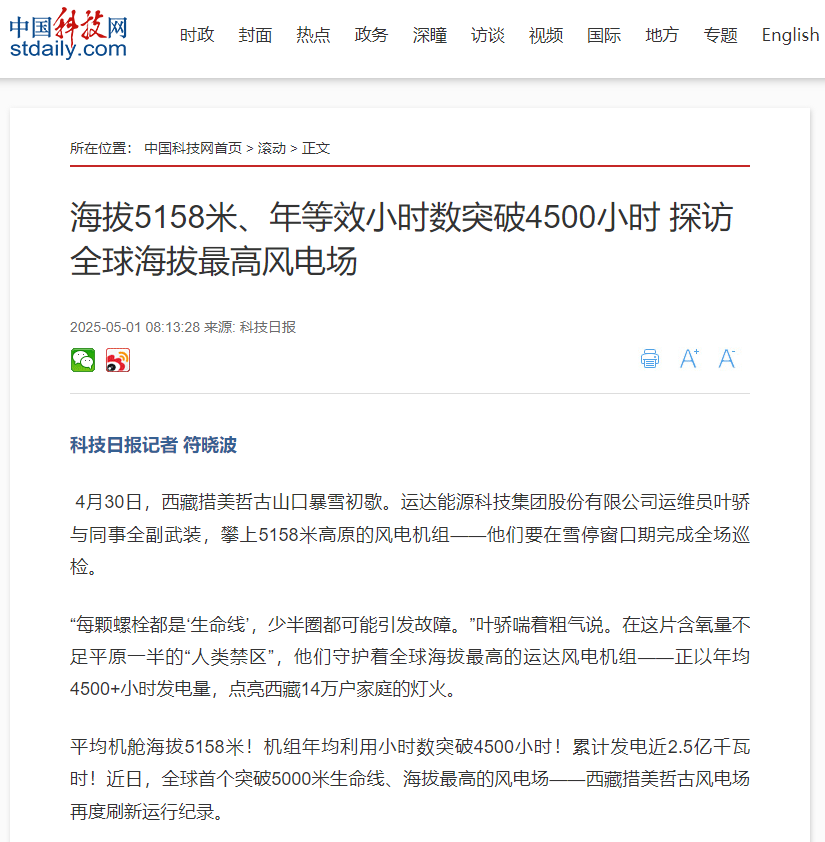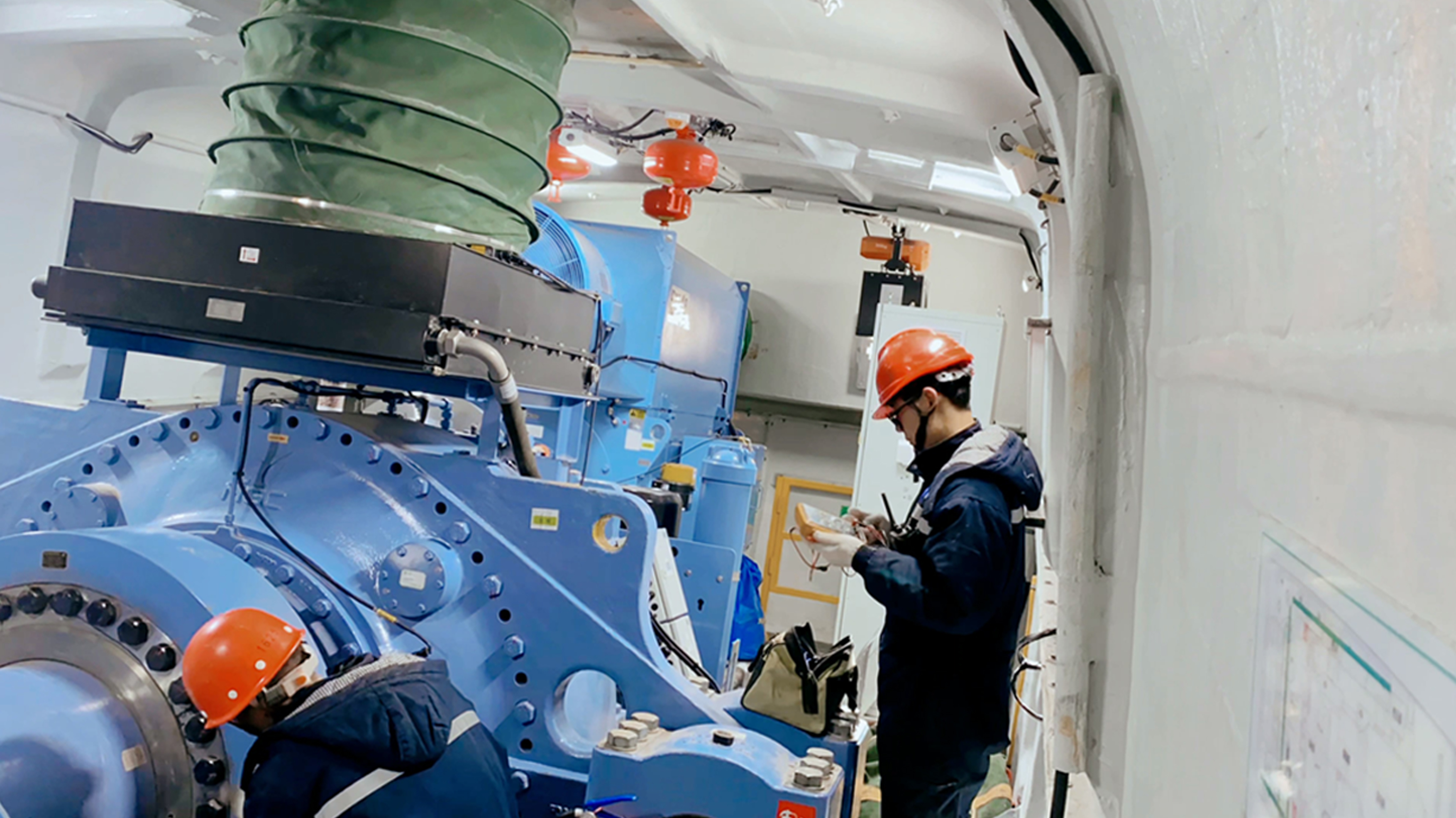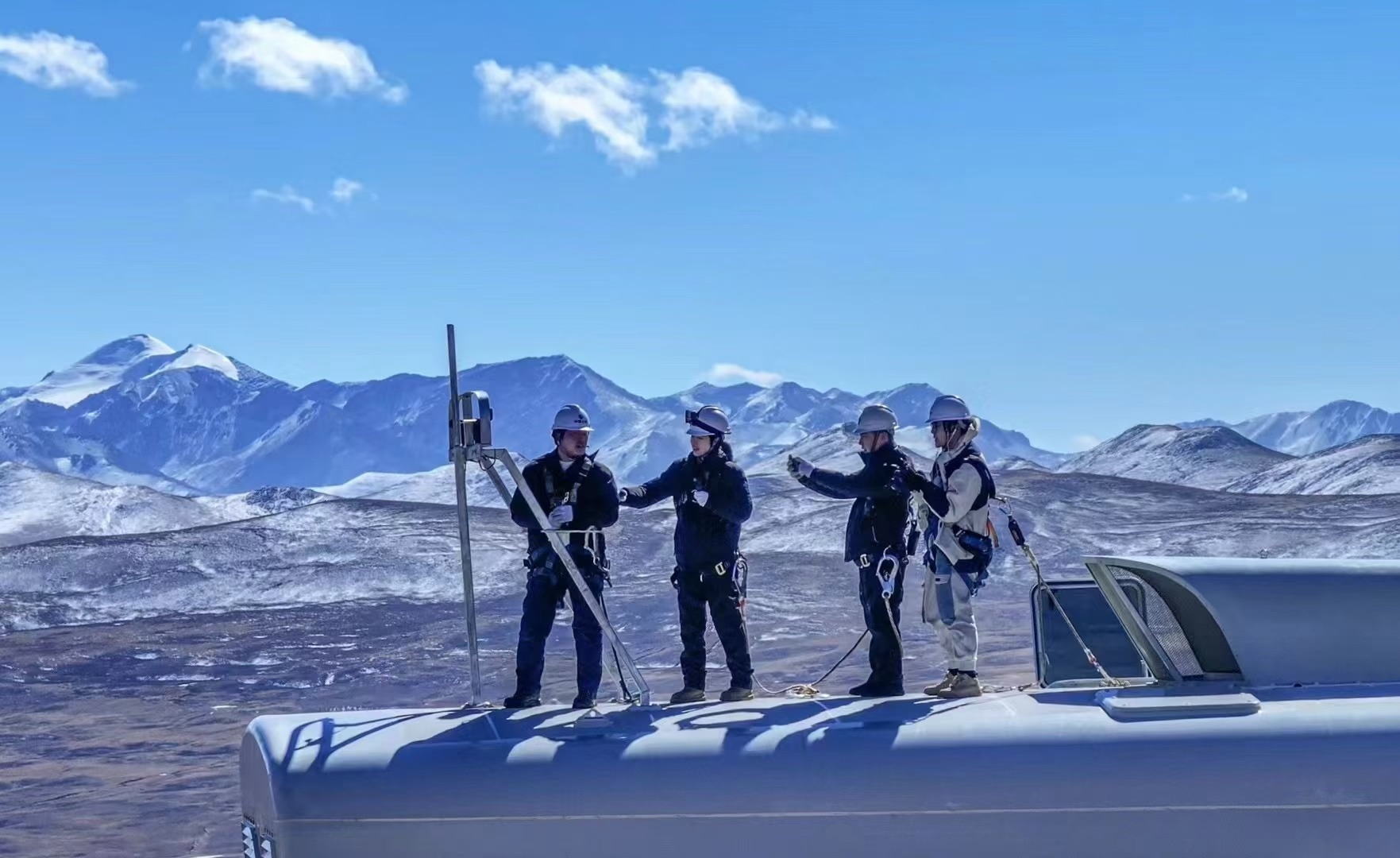On April 30th (or May 1st), stdaily.com made a special report on the Tibet Cuomai Zhegu Wind Farm, the world's highest-altitude wind farm, which once again created its operation record: the average nacelle altitude hit 5,158 meters, the generator set’s annual average available hours exceeded 4500 hours, with cumulative generating capacity of nearly 250 million kilowatt-hours. It’s worth saying that the Tibet Cuomai Zhegu Wind Farm is the world’s first wind farm that exceeds the 5,000-meter “lifeline”, and it was built by WINDEY in part.
How was this record-setting energy miracle achieved? Let's follow the reporter to take a look.

On the night of April 30th, the snowstorm at the Cuomai Zhegu Pass in Tibet just subsided, and the wind speed suddenly rose to 25 meters per second. Then, Ye Jiao, an operation and maintenance staff of WINDEY, and his colleagues, were fully equipped, and they climbed up the wind turbine on the 5,158-meter-high plateau. They needed to complete the site inspection during the halt of the snowstorm.

"Every bolt is a 'lifeline'. Tightening the bolt half a turn less may cause a malfunction," Ye Jiao said while gasping for breath. In this "Human Forbidden Zone" where the oxygen content is less than half of that on the flatland, they are safeguarding the WINDEY wind turbines with the highest altitude in the world, which are lighting up 140,000 households in Tibet with an annual generating capacity of over 4,500 hours.
The "Ultimate Precision" behind a Bolt
Although spring with flowers in full bloom has long embraced the flatland, the temperature inside the nacelle at an altitude of 5,158 meters, however, was only minus 28 degrees Celsius. Ye Jiao knelt on the steel plate and adjusted the torque sensor with his freezing and numb fingers. He was ordered to conduct a re-inspection to 1,300 high-strength bolts. Since the tightening torque tolerance for each bolt must be controlled within 5%, tightening half a turn less might lead to a chain of risks. "It's like threading a needle on the top of Mount Everest," he said.

It’s the "key&core technology" from WINDEY that supports this “millimeter-level operation and maintenance”: The nano anti-ultraviolet coating on the blade helps greatly bring down the aging rate, the special lubricating oil for gearbox at minus 40 degrees Celsius helps significantly reduce the shutdown rate, and the intelligent pitch control system helps calibrate air pressure fluctuations at any moment. “Our generator sets are equipped with seven layers of 'Tech Armor'," said Engineer Chen Da, who were pointing at the smooth curve on the monitoring screen. "Even though the air density is only half of that on the flatland and the temperature difference in a single day is as high as 40 degrees Celsius, the generator set can still operate stably."
The “Soft Power” of the operation and maintenance team is another eye-catching point. At the project site, not just is the “24-hour Shift Rotation + Double Spare Parts Reserve" rule implemented, but also the emergency response standard "1 Hour for Troubleshooting + 4 Hours for Repair" has been formulated, with the efficiency rising by 40%. As the main power source during the dry season in Tibet, the Cuomai Zhegu Wind Farm supplied 35% of the Zhegu County's electricity in the winter of 2024, and it was also rated as an advanced collective for power supply in the Tibet Autonomous Region.
The "First Standard" for Global High-altitude Wind Power
The large screen at the centralized control center was showing the real-time wind speed of the Qinghai-Tibet Plateau. Engineer Yang Changli clicked the mouse gently, and then those wind turbines, dozens of kilometers away from the center, immediately switched into the "Anti-turbulence Mode", converting the rampant high-altitude wind into a stable electric current with an availability rate of 99.97%.

In the past, due to multiple challenges such as low air density, low atmospheric pressure, high radiation intensity, and high frequency of thunderstorms, plateaus with an altitude exceeding 5,000 meters had always been labeled “Lack of value for development for weak wind energy”. However, WINDEY "went against the trend" and became the "first to take the plunge".
In face of the world's first ultra-high-altitude wind power demonstration project, WINDEY not only adopted a series of targeted measures during the design and manufacturing stages, but also kept monitoring and studying the operation effect after the project was put into operation.

"We've equipped each generator set with 'black box'," Yang Changli showed the operation logs, on which there were thousands of plateau-exclusive parameters. Relying on the "black box", WINDEY has built the world's first 5,000-meter-level wind power intelligent operation and maintenance model and took the lead in formulating the High-Altitude Wind Power Operation and Maintenance Standards, providing technical parameters and standards for the development of the subsequent "Wind Power Sky Roads".
Nowadays, this “Green Revolution” is still underway. Yang Changli said: "These parameter standards have become the 'Chinese standards' for 5,000-meter-level wind power throughout the world. They are not only vigorously promoted in China, but are being extensively 'copied and pasted' by plateau countries such as Nepal and Peru along with the commissioning of the Qinghai-Tibet DC Phase II Expansion Project in 2025."
"Wind Power Sky Road" Benefits the People’s Livelihoods on the Plateau
At the foot of the mountain, Gesang Wangla, who was a herdsman, was inspecting the spare parts in the maintenance warehouse. This Tibetan young man is now an operation and maintenance worker of the Cuomai Zhegu Wind Farm, with a monthly income exceeding RMB 12,000."In the past, my family used butter lamps for lighting. Now that I earn a salary, I've equipped my home with all sorts of electrical appliances," he said, opening his yellowed notebook, on which the “Ten Iron Rules for Plateau Operation and Maintenance" were recorded in both Tibetan and Chinese - from ultraviolet protection to tool warm-up standard, and even the breathing rhythms at different altitudes were annotated.

"There are 14 young people like Gesang Wangla in our team," Ye Jiao told the reporter, saying that more than half of the wind farm's operation and maintenance team members are recruited from local Tibetan young people.
What this "Wind Power Sky Road" has brought is far more than job opportunities. Today, the Tibet Cuomai Zhegu Wind Farm has generated nearly 250 million kilowatt-hours of electricity in total, with electricity price for herdsmen dropping directly from RMB 1.2 per kilowatt-hour to RMB 0.5. A more profound change is hidden in the meadow: Through the "Seed Spraying + Ecological Retaining Wall" technology, the 160 hectares of degraded land around the wind farm has regained its greenery, and the 160,000 tons of carbon dioxide emission reduction is equivalent to "planting" 1,600 hectares of forests at the source of the Yangtze River. "When the generator sets are running, Tibetan antelope herds are grazing just a hundred meters away," Gesang Wangla said. Such a "Green Electricity + Livelihood" pattern is also being replicated in more new projects of Nagqu, Ali and other places - perhaps this is the most enchanting song dedicated to the times by the plateau workers.


